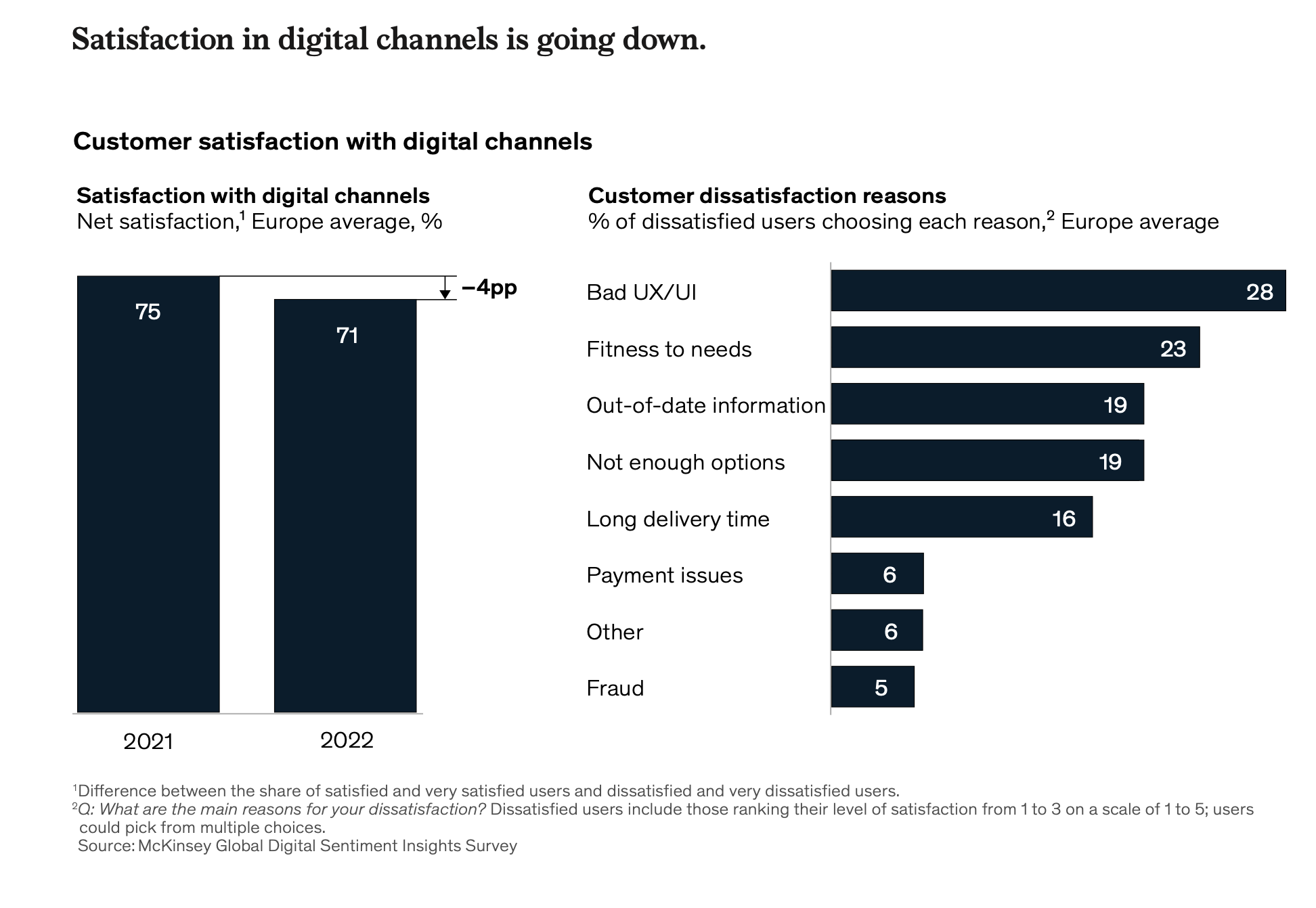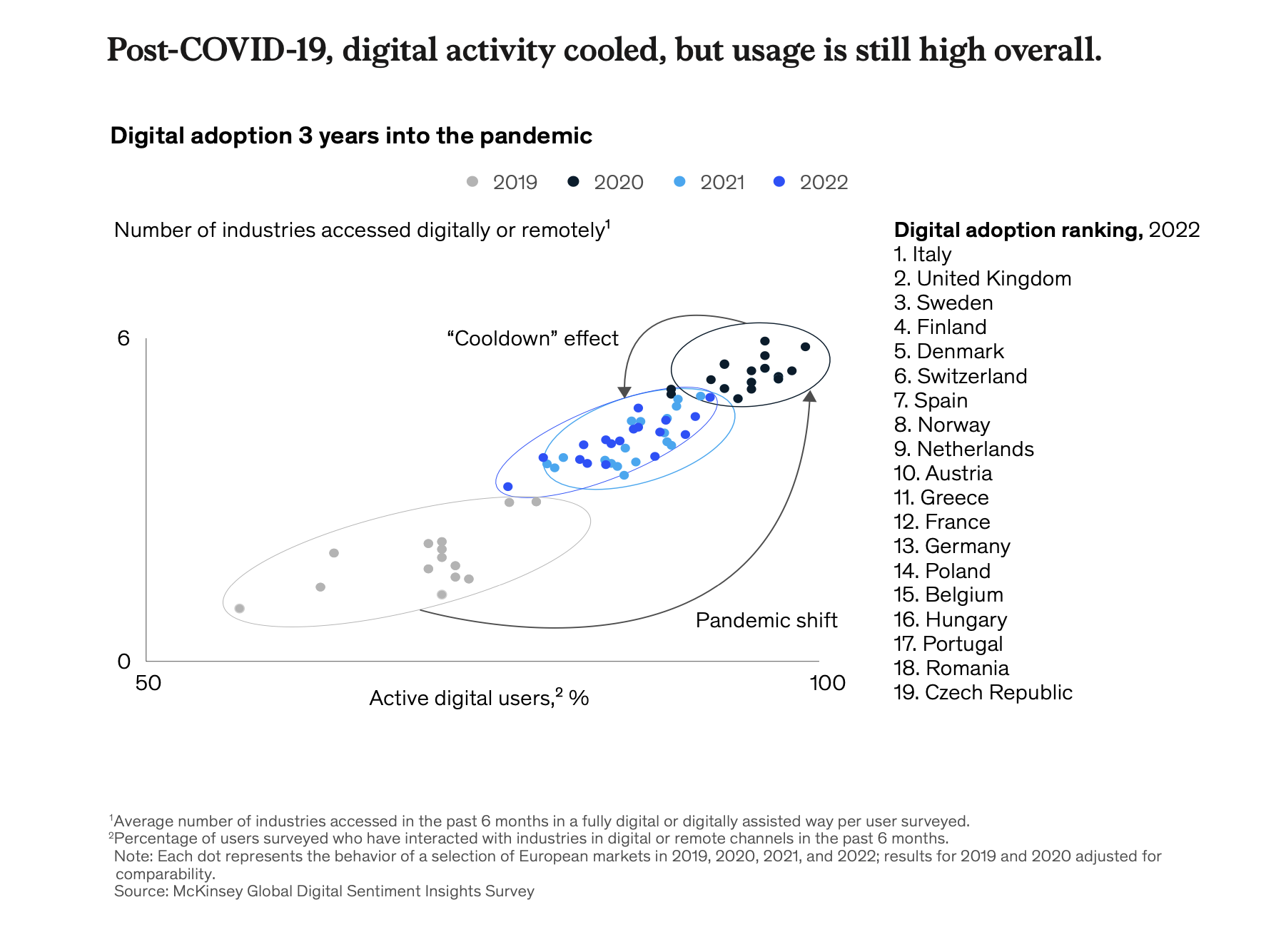|
Getting your Trinity Audio player ready...
|
Across the world, we’ve seen exponential digital growth. McKinsey’s latest report on digital reported a net gain of 100 million digital users across Europe since 2019. That’s a whopping 13% of the total population of Europe! Today, we examine the state of digital within publishing and look at how publishers can improve their digital offering.
High frequency of digital users are young and mobile
High digital users (who interacted digitally with more than 7 industries) tend to be younger and live in urban areas according to McKinsey. These demographics are no surprise, having been more likely to grow up in the age of digital. For industries across the world, this younger demographic is the golden ticket to the future.

Mobile is quickly becoming home for these users. As we saw in 2022’s Reuters Digital Report, mobile has become the dominant device for news consumption. 47% of under-35s and 28% of 35-65’s now use mobile as their first device to access news. McKinsey report that industries with higher mobile app utilisation as the primary channel of contact tend to have a larger share of fully digital users. With mobile usage increasing, publishing is well on its way to becoming a primarily digital industry.
Publishers are seeing increasing number of digital downloads
Digital news is becoming the norm and as a result publishers have noticed similar levels of digital growth. There are now 10 publishers in the 1 million club of digital subscribers and many more showing signs of record digital growth in recent years. With publishers moving to cut print days in light of environmental and economic pressure, the importance of digital will only increase.
The Economist recently became the 10th member of this 1 million subscriber club with their shift to a “decisively digital” plan. In an interview with INMA, Deputy Editor and Head of Digital Strategy at The Economist Tom Standage put this digital growth down to a belief that fundamental belief in the importance of product teams.
“Everyone expects products to work as well as Netflix or the customer service to be as good as Amazon.”
Tom Standage, Deputy Editor and Head of Digital Strategy at The Economist
ePapers and digital editions are fast becoming central to the success of digital strategies. They provide a strategic conversion and retention tool which can be used to engage subscribers at all steps of the funnel. They provide a premium and finite experience for daily news consumption. At Twipe, we have seen an increased demand in downloads of our customer’s titles.

The graph above shows the significant growth in edition downloads for one particular customer. Edition downloads on their platform almost doubled within the space of a year thanks to their decision to focus on the quality of the ePaper experience.
User experience and trust still need to be improved
There is still work to be done to provide flawless experiences in the digital world. McKinsey found that customer satisfaction with digital experiences dropped 4% from 2021. As a result, poor user experience tops the list of pain points for 28% of dissatisfied users and finding products that fit particular needs is a major concern for 23% of users. Publishers need to increase their focus on providing their content in the best possible way for their audiences and making their products as relevant as possible. Perhaps recent shifts into providing more services than just news are turning consumers away?

It is critical for publishers to remember the importance of their app. A recent Mather report found that consumer spending on subscriptions is likely to remain steady, therefore retention is key. With the knowledge that 58% of people feel loyal to brands based on their app performance, apps are more important than ever. So, whilst the pandemic encouraged many to go for quick fixes, now is the time to move towards providing flawless and more permanent features.
Another worrying finding in McKinsey’s survey was that consumers are losing trust in digital channels, which was 2% lower compared with 2021. The main sources of distrust are the handling of personal data and cyberattacks. For news in particular, trust levels are down at just 42%. Reuters found that this lack of trust in personal data is a key reason why readers will not register their data to read articles on publisher’s websites. At last year’s Digital Growth Summit (join us for this year’s summit on 19th October in London!), CIO/CTO of Le Monde Sacha Morard identified rebuilding trust as the biggest challenge facing news publishers going forward. Rebuilding trust is a long mission which will be interesting to follow.
Is there a digital divide?
Whilst digital growth is great, it is worth taking a moment to look at the flipside. Wired uncovered that around 2.9 billion people (37% of the world’s population) have never used the internet, according to the International Telecommunication Union (ITU). This is a staggering number to comprehend. The demographics behind these numbers though are less difficult to imagine.
High digital adopters who have interacted digitally with more than 7 industries have more education and higher available incomes than their peers. When focusing on Europe in particular, McKinsey discovered that countries where per capita GDP was less than €30,000 (the Czech Republic, Hungary, Poland, and Romania) had a much lower level of digital adoption. Less spending power means less access to digital devices and high speed internet access. Remembering these often-forgotten demographics should be at the heart of publisher’s plans.

Some publishers have moved to help these readers. Arkansas-Democrat Gazette provided their readers with iPads to access their ePaper and provided lessons on how to use their devices and apps. The Daily Mail sent Amazon tablets to their Black Friday and Cyber Monday subscribers to save them the cost of buying a tablet to access their premium ePaper product. These are great starts, but there is more to be done.
Digital clearly is the future and publishers must adapt. Providing flawless experiences, particularly on mobile, will be key for future success in the battle with competitors. But publishers must also be careful not to forget about their non-digital demographics. They must become their partner in life for this transition to help them every step of the way.
Matthew Lynes
Media Innovation Analyst @ Twipe
Get Twipe’s weekly insights on digital publishing, artificial intelligence, and paid content in your mailbox. Sign up here.


